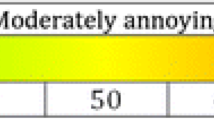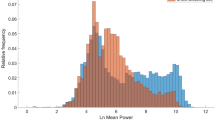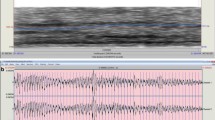Abstract
Frequency analysis of snoring sounds has been reported as a diagnostic tool to differentiate between different sources of snoring. Several studies have been published presenting diverging results of the frequency analyses of snoring sounds. Depending on the position of the used microphones, the results of the frequency analysis of snoring sounds vary. The present study investigated the influence of different microphone positions on the outcome of the frequency analysis of snoring sounds. Nocturnal snoring was recorded simultaneously at six positions (air-coupled: 30 cm middle, 100 cm middle, 30 cm lateral to both sides of the patients’ head; body contact: neck and parasternal) in five patients. The used microphones had a flat frequency response and a similar frequency range (10/40 Hz–18 kHz). Frequency analysis was performed by fast Fourier transformation and frequency bands as well as peak intensities (Peaks 1–5) were detected. Air-coupled microphones presented a wider frequency range (60 Hz–10 kHz) compared to contact microphones. The contact microphone at cervical position presented a cut off at frequencies above 300 Hz, whereas the contact microphone at parasternal position revealed a cut off above 100 Hz. On an exemplary base, the study demonstrates that frequencies above 1,000 Hz do appear in complex snoring patterns, and it is emphasised that high frequencies are imported for the interpretation of snoring sounds with respect to the identification of the source of snoring. Contact microphones might be used in screening devices, but for a natural analysis of snoring sounds the use of air-coupled microphones is indispensable.






Similar content being viewed by others
References
Agrawal S, Stone P, McGuinness K, Morris J, Camilleri AE (2002) Sound frequency analysis and the site of snoring in natural and induced sleep. Clin Otolaryngol Allied Sci 27:162–166. doi:10.1046/j.1365-2273.2002.00554.x
Beck R, Odeh M, Oliven A, Gavriely N (1995) The acoustic properties of snores. Eur Respir J 8:2120–2128. doi:10.1183/09031936.95.08122120
Caffier PP, Berl JC, Muggli A, Reinhardt A, Jakob A, Moser M, Fietze I, Scherer H, Holzl M (2007) Snoring noise pollution—the need for objective quantification of annoyance, regulatory guidelines and mandatory therapy for snoring. Physiol Meas 28:25–40. doi:10.1088/0967-3334/28/1/003
Fiz JA, Abad J, Jane R, Riera M, Mananas MA, Caminal P, Rodenstein D, Morera J (1996) Acoustic analysis of snoring sound in patients with simple snoring and obstructive sleep apnoea. Eur Respir J 9:2365–2370. doi:10.1183/09031936.96.09112365
Hara H, Murakami N, Miyauchi Y, Yamashita H (2006) Acoustic analysis of snoring sounds by a multidimensional voice program. Laryngoscope 116:379–381. doi:10.1097/01.mlg.0000195378.08969.fd
Herzog M, Schmidt A, Bremert T, Herzog B, Hosemann W, Kaftan H (2008) Analysed snoring sounds correlate to obstructive sleep disordered breathing. Eur Arch Otorhinolaryngol 265:105–113. doi:10.1007/s00405-008-0585-0
Hill PD, Lee BW, Osborne JE, Osman EZ (1999) Palatal snoring identified by acoustic crest factor analysis. Physiol Meas 20:167–174. doi:10.1088/0967-3334/20/2/306
Jones TM, Ho MS, Earis JE, Swift AC, Charters P (2006) Acoustic parameters of snoring sound to compare natural snores with snores during ‘steady-state’ propofol sedation. Clin Otolaryngol 31:46–52. doi:10.1111/j.1749-4486.2006.01136.x
Jones TM, Swift AC, Calverley PM, Ho MS, Earis JE (2005) Acoustic analysis of snoring before and after palatal surgery. Eur Respir J 25:1044–1049. doi:10.1183/09031936.05.00101703
Kaniusas E, Pfutzner H, Saletu B (2005) Acoustical signal properties for cardiac/respiratory activity and apneas. IEEE Trans Biomed Eng 52:1812–1822. doi:10.1109/TBME.2005.856294
Kraman SS, Wodicka GR, Pressler GA, Pasterkamp H (2006) Comparison of lung sound transducers using a bioacoustic transducer testing system. J Appl Physiol 101:469–476. doi:10.1152/japplphysiol.00273.2006
Miyazaki S, Itasaka Y, Ishikawa K, Togawa K (1998) Acoustic analysis of snoring and the site of airway obstruction in sleep related respiratory disorders. Acta Otolaryngol 537:47–51. doi:10.1080/00016489850182350
Osborne JE, Osman EZ, Hill PD, Lee BV, Sparkes C (1999) A new acoustic method of differentiating palatal from non-palatal snoring. Clin Otolaryngol Allied Sci 24:130–133. doi:10.1046/j.1365-2273.1999.00229.x
Perez-Padilla JR, Slawinski E, Difrancesco LM, Feige RR, Remmers JE, Whitelaw WA (1993) Characteristics of the snoring noise in patients with and without occlusive sleep apnea. Am Rev Respir Dis 147:635–644
Quinn SJ, Huang L, Ellis PD, Williams JE (1996) The differentiation of snoring mechanisms using sound analysis. Clin Otolaryngol Allied Sci 21:119–123. doi:10.1111/j.1365-2273.1996.tb01313.x
Rembold CM, Suratt PM (2004) Children with obstructive sleep-disordered breathing generate high-frequency inspiratory sounds during sleep. Sleep 27:1154–1161
Saunders NC, Tassone P, Wood G, Norris A, Harries M, Kotecha B (2004) Is acoustic analysis of snoring an alternative to sleep nasendoscopy? Clin Otolaryngol Allied Sci 29:242–246. doi:10.1111/j.1365-2273.2004.00800.x
Schafer J (1989) How can one recognize a velum snorer? Laryngorhinootologie 68:290–294
Sola-Soler J, Jane R, Fiz JA, Morera J (2007) Automatic classification of subjects with and without sleep apnea through snoring analysis. Conf Proc IEEE Eng Med Biol Soc 1:6093–6096. doi:10.1109/IEMBS.2007.4353739
Sola-Soler J, Jane R, Fiz JA, Morera J (2005) Variability of snore parameters in time and frequency domains in snoring subjects with and without obstructive sleep apnea. Conf Proc IEEE Eng Med Biol Soc 3:2583–2586
Conflict of interest statement
The authors declare that they have no conflict of interest.
Author information
Authors and Affiliations
Corresponding author
Rights and permissions
About this article
Cite this article
Herzog, M., Kühnel, T., Bremert, T. et al. The impact of the microphone position on the frequency analysis of snoring sounds. Eur Arch Otorhinolaryngol 266, 1315–1322 (2009). https://doi.org/10.1007/s00405-008-0858-7
Received:
Accepted:
Published:
Issue Date:
DOI: https://doi.org/10.1007/s00405-008-0858-7




